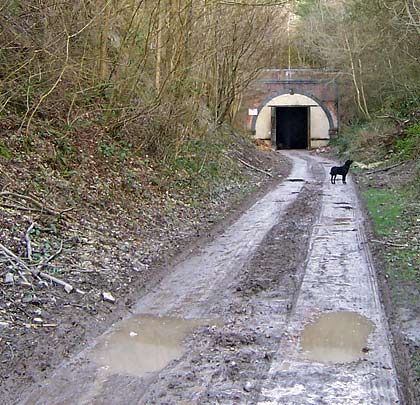Privett and West Meon tunnels
Privett and West Meon tunnels














The Meon Valley Railway joined Alton and Fareham in Hampshire, opening as recently as 1903. Despite being a single line, the two tunnels near the route’s summit were both built to accommodate double track. Privett – 1,058 yards long – claimed the life of a navvy during construction when a collapse occurred. A second dug himself free. The route’s central section, including Privett and West Meon tunnels, closed to all traffic in 1955.
Click here for more info from Wikipedia.
Simon’s report on Privett:
The southern approach cutting has been churned up from years of tractor use. Entry to the tunnel is only possible via the this portal which is bricked up around a pair of high metal doors. Graffitti lines the walls – dated from around 1982 and earlier, yet still in pristine condition due to the dry, cool atmosphere.
About 100 yards in is a wooden BMX/skateboard track and what looks like a youth club, with settees and posters. Privett used to house a mushroom farm but is now owned by a builder. Along it’s 1,056 yard length, there are building materials – chimney pots, double glazing, cement mixers, sand bags, bricks, pipes.
About half way in, a few old cars are dumped all with mold-covered interiors. There are also old filing cabinets with paperwork (possibly from a solicitors) dating from the early Eighties.
The interior is brick-lined (still in good condition) but, towards the middle, is divided by sections of cast concrete alternating every 25-30 metres. It is dry, still and cool inside, although the humidity is high. Refuges are located every 25 metres and the single line was laid on the east side of the bore. This was clear from the soot deposits on the roof. Despite its length, there are no air vents.
Privett is built on an S-shape curve which makes it very dark in the middle. Sound echoes for ages.
It is a designated haven for bats. 100 metres from the northern portal, there is a breeze block wall, dividing the tunnel into two sections. The space beyond is a breeding area. The wall has a door which will only open from the south side – you have to walk the tunnel’s length to open it.
The northern portal has been bricked up to within 1 metre of the crown – this gap provides access for the bats. The approach cutting has been backfilled right up to the portal. You can get down to it from the road but it is steep.
There is little evidence inside the tunnel to show a railway once ran through it, only the brackets which held the telegraph wires.
Simon’s report on West Meon:
Again, West Meon Tunnel is owned by a builder and this also has lots of building materials inside. Entry can only be made through the northern portal which has two huge doors. Just inside, the walls have been painted magnolia, giving the appearance of an industrial unit or similar. It is easy to see charring on the roof where the tunnel had a fire years ago.
The tunnel is also a store for caravans, cars and a massive pile of decaying metal parts. Until the Eighties, it was used by a scrap dealer to break up Cold War aircraft. Inside was much like Privett – cool, dry and reasonably humid. There are no air vents. The wall and roof lining are completely brick, with refuges every 25 metres or so.
The southern portal is blocked off and the cutting backfilled, partly obscuring the portal. Inside, the owner has built a raised office space with a heating system which includes a silver exhaust pipe to the outside world.Like Privett, West Meon is a bat haven although it has minimal provisions. Both tunnels have solid, level floors although West Meon’s is rather more pitted and worn.
 July 2008
July 2008




